New Colonies from New England to Georgia
New England: The Puritan Diaspora. Not everything in New England was agreeable. The Puritans were passionate people with strong beliefs, and like all human beings, they had differing opinions on important matters from time to time. Although their thinking was rooted in the Bible, the Bible is sometimes ambiguous in terms of religious doctrine. For example, in one book of the New Testament claims that man is saved by faith alone; in another it is claimed that faith without works is dead. Thus, when arguments arose, they could not always be resolved by resorting to the scripture. Within a few years of the settlement of Massachusetts Bay, various groups began to break off and establish new colonies towns and eventually new colonies. Because of the way New England expanded, however, the similarities among the New England colonies probably outweigh the differences. Throughout the 17th century, the New England colonies were dominated by the Puritan faith.
Connecticut
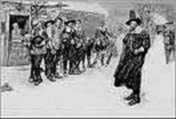 Not all the motivation was over religious differences, however; the relatively rocky and unfriendly coast of Massachusetts was not as appealing as, for example, the Connecticut River Valley. Thomas Hooker was the pastor in Newtown, Massachusetts, in the early 1630s. Because of his differences with the leadership of the Massachusetts colony in the person of Governor Winthrop, Hooker decided to take his flock westward, and in 1636 his entire congregation set out for the Connecticut River Valley, which had been discovered by Dutchman Adrian Block some years earlier. There Hooker founded the town of Hartford. Other groups from Massachusetts later founded additional towns in the Connecticut Valley. The colony of New Haven, led by the Reverend John Davenport, was founded in 1637, and Stamford was settled in 1641. Additional towns joined with them to create the New Haven colony.
Not all the motivation was over religious differences, however; the relatively rocky and unfriendly coast of Massachusetts was not as appealing as, for example, the Connecticut River Valley. Thomas Hooker was the pastor in Newtown, Massachusetts, in the early 1630s. Because of his differences with the leadership of the Massachusetts colony in the person of Governor Winthrop, Hooker decided to take his flock westward, and in 1636 his entire congregation set out for the Connecticut River Valley, which had been discovered by Dutchman Adrian Block some years earlier. There Hooker founded the town of Hartford. Other groups from Massachusetts later founded additional towns in the Connecticut Valley. The colony of New Haven, led by the Reverend John Davenport, was founded in 1637, and Stamford was settled in 1641. Additional towns joined with them to create the New Haven colony.
The Fundamental Orders of Connecticut were written in 1639. Although the Mayflower compact had laid down the broad outlines of government, the Fundamental Orders filled in the details and became the first full-blown constitution written for government in America. The orders contained no reference to the British government; thus the document occupies an important place in American political history.
Eventually the settlers on the north shore of Long Island Sound merged with the Puritans in the Connecticut River Valley. Although the Dutch colony at New Amsterdam had claimed parts of Connecticut, the English settlers eventually controlled the colony. Following a bloody war with the Pequot Indians, known as the Pequot War, the people of Connecticut obtained a charter from Charles II. As was the case with most colonial charters, the only restriction was that the laws of the colony must conform to the laws of England.
Rhode Island and Providence Plantations
The founder of the Rhode Island colony was Roger Williams, a dissenter from Massachusetts who had more liberal ideas than some of the Puritan fathers in the Massachusetts Bay colony. A very learned man and a brilliant thinker, Williams had been closely acquainted with some of England's leading figures before coming to America. As a young man Williams came to the attention of Sir Edward Coke, a famous English jurist, who supported Williams's education, which he completed at Cambridge University. He was also acquainted with Sir Francis Bacon, who no doubt influenced Williams's thinking, contributing to his intellectual rigor.
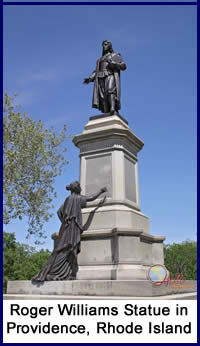 When banished from Massachusetts for his religious beliefs, Williams established a colony in a unsettled area after purchasing land from Indians. He named his settlement Providence, which eventually merged with other settlements such as Newport and eventually became the colony of Rhode Island. Williams obtained a charter from Parliament in 1643 for Rhode Island and Providence Plantations, which gave the colony the right to govern itself.
When banished from Massachusetts for his religious beliefs, Williams established a colony in a unsettled area after purchasing land from Indians. He named his settlement Providence, which eventually merged with other settlements such as Newport and eventually became the colony of Rhode Island. Williams obtained a charter from Parliament in 1643 for Rhode Island and Providence Plantations, which gave the colony the right to govern itself.
Williams believed in the separation of church and state, and thus is a revered figure in the history of American ideas of religious freedom. In his most famous work on theology, Williams argued that because of all the blood that had been spilled over religious issues in wartime, governments should not take it upon themselves to enforce religious views on their people. He claimed that civil officials had no right to judge people's religious views. He based his views on the Bible and claimed that Scripture prohibited “uniformity of religion to be enacted and enforced in any civil state.”
The colony attracted freethinkers of all kinds, including Anne Hutchinson, who was found guilty of heresy in her famous trial in Massachusetts, as well as her followers. Although the government of Rhode Island was not fully democratic, the settlers nevertheless felt free to express themselves in various ways, with the result that Rhode Island was one of the more turbulent colonies in early America.
Because of the conflict between King Charles I and Parliament that led to the English Civil War, Rhode Island’s charter was declared invalid following the restoration of Charles II. Rhode Island then got a new charter, which affirmed the rights granted under the first charter and included a land grant. It also declared that people should be free of any sort of persecution “for any difference in opinion in matters of religion.” That provision reflected the feelings of Roger Williams himself, and the idea continued to grow as the American colonies developed. So liberal was the religious posture of Rhode Island that Roman Catholics, Jews and even non-believers were welcome in the colony. Rhode Island remained, however, something of an outcast among the rest of the colonies for its different ways. (Following the American Revolution, Rhode Island was the only state that did not send a delegation to the Constitutional Convention in 1787.) Yet the people of Rhode Island felt strongly about their views and defended their positions against the other New England colonies.
New Hampshire
The territory that became New Hampshire was part of a 1622 land grant established by the Council for New England. The first small settlement was eventually expanded by colonists from Massachusetts. A number of small towns were created. They had difficulty establishing a system of government and remained under the jurisdiction of Massachusetts until 1679, when they were separated by the Crown. James II rejoined them again in 1686, but in 1691 New Hampshire became a royal colony. The colony grew slowly because of conflicts over land ownership, but in 1717 a group of Scotch-Irish settlers entered the colony and established the town of Londonderry, and a thriving textile business soon grew up.
The western portion of the New Hampshire colony was also claimed by New York, which eventually won the territory, but later it broke off and became a separate colony of Vermont, which in turn became the 14th state in the Union. The territory of Maine remained part of Massachusetts until 1820. Although the separate New England colonies developed separately, often as a result of theological disputes, the general character on New England was not only consistent within its colonies, but many cultural ideas spread from New England across New York and into the Middle West.
The Middle Colonies
Maryland
George Calvert, who became the first Lord Baltimore, was granted territory in the American colonies north of the Potomac River in 1632. The charter authorized the proprietor, Cecelius Calvert, the second Lord Baltimore, to recognize religions in the colony other than Protestants, and thus the Maryland colony became a haven for Catholics. The first Catholics arrived in 1634 and settled at St. Mary’s in the southern part of the colony. The Virginia colony had established a trading post within Maryland’s boundaries, leading to conflict between the two colonies, which was eventually resolved in favor of Maryland.
In 1649 Maryland passed its famous Toleration Act, which assured religious freedom to anybody who recognized the doctrine of the Trinity. A later assembly repealed the toleration act, however, and conflict between Catholics and Protestants within the colony continued until the early 1680s. Additional conflict arose between the Maryland and Pennsylvania colonies regarding the southern boundary of Pennsylvania. Two English surveyors, Charles Mason and Jeremiah Dixon, surveyed the line that eventually became known as the Mason-Dixon line, later recognized as a dividing line between slave and free states. Following the Glorious Revolution of 1688 it was thought that the Maryland colony would once again be turned over to Catholics, but in 1695 the capital was moved from St. Mary’s to Annapolis, located in the more “Protestant” area of Maryland. For a time Maryland was a royal colony, but eventually the charter was restored and the fourth Lord Baltimore continued as proprietor.
New York
In 1609 Henry Hudson explored for the Dutch East India Company in the Hudson Valley area, and additional exploratory journeys followed along the New York, Connecticut, and New Jersey coasts. In 1621 the Dutch West India Company was founded, and its charter granted the company the right to colonize in the New World. The first permanent settlement of New Amsterdam was created in 1624, and Peter Minuet arrived in 1626 with a group of settlers and purchased Manhattan Island from the Native Americans for about $24 in trading goods. He named the colony New Netherland. The Dutch settlements expanded up the Hudson River as far as Fort Orange opposite what became Albany. Large landowners were known as patroons and received favorable treatment from the owners of the company.
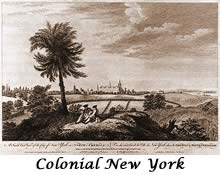 Although the British and Dutch had been on friendly terms for some time, the Dutch colony separated New England from Virginia; as economic competition between the two nations grew, the Dutch colony began to be seen as an impediment. King Charles II granted the territory between the Delaware and Connecticut rivers to his brother James, the Duke of York, but this claim challenged the Dutch claim of the same area. The authority of the Navigation Acts began to be enforced against the Dutch trading competition, and in 1664 ships of the Royal Navy sailed into New Amsterdam harbor and forced the Dutch governor Peter Stuyvesant to surrender. (More about Navigation Acts below.)
Although the British and Dutch had been on friendly terms for some time, the Dutch colony separated New England from Virginia; as economic competition between the two nations grew, the Dutch colony began to be seen as an impediment. King Charles II granted the territory between the Delaware and Connecticut rivers to his brother James, the Duke of York, but this claim challenged the Dutch claim of the same area. The authority of the Navigation Acts began to be enforced against the Dutch trading competition, and in 1664 ships of the Royal Navy sailed into New Amsterdam harbor and forced the Dutch governor Peter Stuyvesant to surrender. (More about Navigation Acts below.)
The Duke of York renamed the New Netherland territory New York, and although it was now under English control, the Dutch settlers were indifferent to the change in rule as long as they retained their holdings, as the period of Dutch rule had not been amenable to them. Soon large English landholders existed along with the Dutch patroonships. Seeking to strengthen his political position within the realm, James granted a portion of his holdings to Sir John Berkley and Sir George Carteret, whose territory eventually became the New Jersey colony.
Both New York and New Jersey were exceedingly diverse with Dutch, Scandinavians, Germans, French Huguenots, and African slaves. To the south of New Jersey the colony of New Sweden was established on the Delaware River in 1637. Settlement began in 1638. Fort Christina, which eventually became the city of Wilmington, was the center of New Sweden. Settlers also moved into the area that bordered Pennsylvania.
Ties between the English and Dutch were once again strengthened by the marriage of the Dutch Prince William of Orange to James’s daughter Mary. When James openly avowed his Catholic faith and was removed from the throne in the Glorious Revolution of 1688, the Crown was offered to William and Mary jointly and they acceded in 1689. When Mary died in 1694, William continued as King William III.
In 1735 an event occurred in New York that had significant implications for the future of the freedom of the press in America. The governor of New York lost a case before the Supreme Court of New York and subsequently fired the judge. Peter Zenger, a newspaper publisher, criticized the governor in his New York Weekly Journal, and the governor angrily ordered Zenger arrested for libel and that his paper be shut down. Defense attorney Andrew Hamilton of Philadelphia defended Zenger and obtained for his client the decision of the jury, which overruled a decision of the judge, a stunning victory for the liberty of the press in America, an important precedent that carried over into and beyond the American Revolution.
The Colony of New Sweden, 1638–1655
The Swedes were the first to make permanent settlement in the Delaware region, beginning with the expedition of 1637–1638, which occupied the future site of Wilmington, Delaware. In 1643 Governor Johan Printz of New Sweden established his capital at Tinicum Island within the present limits of Pennsylvania, where there is now a state park bearing his name.
Dutch Dominion on the Delaware, 1655–1664, and the Duke of York's Rule, 1664–1681
Trouble broke out between the Swedes and the Dutch, who had trading posts in the region. In 1655 Governor Peter Stuyvesant of New Netherlands seized New Sweden and made it part of the Dutch colony. In 1664 the English seized the Dutch possessions in the name of the Duke of York, the king’s brother. Except when it was recaptured by the Dutch in 1673–1674, the Delaware region remained under Duke of York’s jurisdiction until 1681. English laws and civil government were introduced by the Duke of York’s Laws in 1676.
Pennsylvania
The founding of the Pennsylvania colony began when King Charles II awarded a charter in 1681 to William Penn, son of Admiral Sir William Penn, to whom the king owed a debt. The charter, the largest grant ever made to one man in America, was awarded in discharge of the debt on the condition that it would be named for the king’s patron. The resulting Pennsylvania colony took shape as a refuge for Quakers, a radical sect that had been persecuted in England for their unorthodox views. The Quakers were pacifists who refused to pay taxes, did not respect social ranks, and were branded by Parliament as “dangerous.”
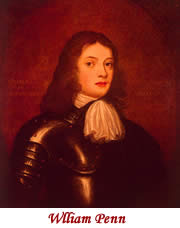 Following the tenets of their founder, George Fox, Quakers found themselves unwelcome in the existing American colonies, especially in Massachusetts, where several of them were hanged as heretics. By the mid-1600s their members numbered in the tens of thousands, and by the time William Penn received his grant from King Charles, he was the best known Quaker in England.
Following the tenets of their founder, George Fox, Quakers found themselves unwelcome in the existing American colonies, especially in Massachusetts, where several of them were hanged as heretics. By the mid-1600s their members numbered in the tens of thousands, and by the time William Penn received his grant from King Charles, he was the best known Quaker in England.
The charter situated the colony to the north of Maryland, but the exact boundary was a bone of contention between Penn and Maryland’s Lord Baltimore. It was not until 1767 that the exact boundary was determined by the English surveyors Mason and Dixon. As the proprietor of the colony, Penn was allowed to determine the shape of the government of Pennsylvania by establishing courts and judges and forming a militia; but the tax power under the charter was retained by Parliament. To expand his domains and give them access to the oceans, he purchased the three counties of the Delaware colony.
The first colonists arrived in Pennsylvania in 1681 under Pennsylvania’s first appointed governor, William Markham. William Penn himself arrived a year later and began to build a city on the spot that became Philadelphia, soon to become the most important city in colonial America. Penn’s approach to the Indians was unusual in that he believed that the Indians were legitimate owners of the land, and he was prepared to pay them a fair price for the areas that Pennsylvania took over. Shortly after arriving, Penn made a formal treaty with the Delaware Indians and promised friendship with them. The treaty remained in effect for decades, and the Indians always considered the Quakers their friends.
In 1683 the colonial legislature of Pennsylvania had begun to function, and it passed laws granting citizenship in the colony to all free Christians. Penn temporarily lost his charter because of issues relating to the Glorious Revolution of 1688 and his friendship with the Duke of York, who would become King James II. Other business affairs kept him in England for an additional time, but when he returned to Pennsylvania he found that the economy had grown and changed considerably in his absence. To revise the government he turned the three counties that constituted Delaware over to the people of that colony to govern themselves.
Noted for its openness to various religions, the Quaker colony soon attracted large numbers of Germans fleeing from religious wars, as well as a stream of Scotch-Irish from the Northern Ireland province of Ulster. The Germans in particular were hardworking, humble, and pious people, many of whose descendants still inhabit Lancaster County, Pennsylvania, and surrounding areas. In their religious devotion, the German sects tended to be very much like the Quakers themselves. Their descendants, the Amish, still live peacefully in Lancaster County.
In 1723 an event occurred in Pennsylvania that did not seem significant at the time, but over the course of the life of the colony it would grow in importance. In that year a young apprentice printer by the name of Benjamin Franklin arrived in Philadelphia from Boston. Franklin’s influence would help to shape not only the colony of Pennsylvania but the destiny of the future United States.
The Southern Colonies
The Carolinas
Many parts of the New World were explored before actual settlements were created, and the southern North American colonies were no exception. Giovanni da Verrazano visited the Carolina coast in the early 1500s, and Spanish explorers from Florida also traveled northward as far as North Carolina.
The first attempt to colonize North Carolina occurred in the 1580s under Sir Walter Raleigh. The first of these attempts failed, but the second colony was established in 1587 under the leadership of John White. This settlement on Roanoke Island eventually became known as the “lost colony.” Because of Great Britain’s preoccupation with the invasion of the Spanish armada, the colony was left to itself for several years. When John White, who had returned to England, sailed back to the colony in 1590, no trace remained except for the word “CROATAN” carved on a tree. The colony is distinguished by the fact that the first English baby born in America was born on Roanoke Island; her name was Virginia Dare. Other than that, little is known of the colony or what became of it. National Geographic page on The Lost Colony.
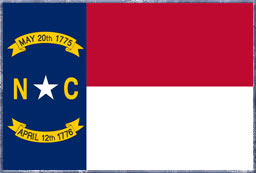 The early settlement of North Carolina occurred in the coastal region in the 1650s as settlers from Virginia drifted into the area, but the Carolinas remained thinly populated until French Huguenots arrived in 1704. Carolina was established under a charter from King Charles II in 1663, given to a group of noblemen who had assisted Charles in regaining the throne during the Restoration. The name Carolina is in honor of Charles II, whose name in Latin is Carolus. The two parts—North and South Carolina—remained a single political unit until 1712, and North Caroline became a crown colony in 1729. Although the two colonies were separated at that time, their histories are similar.
The early settlement of North Carolina occurred in the coastal region in the 1650s as settlers from Virginia drifted into the area, but the Carolinas remained thinly populated until French Huguenots arrived in 1704. Carolina was established under a charter from King Charles II in 1663, given to a group of noblemen who had assisted Charles in regaining the throne during the Restoration. The name Carolina is in honor of Charles II, whose name in Latin is Carolus. The two parts—North and South Carolina—remained a single political unit until 1712, and North Caroline became a crown colony in 1729. Although the two colonies were separated at that time, their histories are similar.
On April 12, 1776, North Carolina became the first colony to vote for independence. Carolinians are quite proud of that fact and have memorialized it on their state flag and the state seal. Above the star on the flag is the date of May 20, 1775, which commemorates the "Mecklenburg Declaration of Independence."
In 1670 additional settlers arrived from Barbados in what became the area of Charleston, South Carolina, where the Ashley and Cooper rivers join and flow into the Atlantic Ocean. The chief sources of revenue for the Carolinas were labor-intensive crops such as rice, indigo, and (later) cotton, as well as exports of wood, resin, and tar from the thick pine forests. The city of Charleston, long the leading city of the South, was actually founded in 1680 and quickly became a leading economic center. The profits from rice and indigo made South Carolina farmers and merchants some of the wealthiest men in that future part of the United States.
Although attempts were made to create an aristocratic government based on heredity in the Carolinas, the American colonies were not favorable to such a social structure. With seemingly unlimited tracts of land available for settlement, attempts to tie the lower classes to a landed gentry proved unsuccessful. Education was not pursued as vigorously in the South as in New England and Pennsylvania, although the wealthier landowners often sent their sons to school in England. Partly because of the more rural nature of the southern colonies, public education was more difficult to sustain. By 1750 the population of the Carolinas was more than 100,000.
The Yamassee War of 1715 between white settlers and Indians disturbed the peace of Carolina for almost a year, and the whites eventually prevailed. Later the people revolted against proprietary rule and requested that their colony be made a royal colony; in 1719 that request was granted and the South Carolina charter was ended, making South Carolina a royal colony.
Georgia
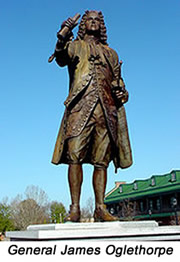 The last colony of the original thirteen was the southernmost colony of Georgia, named for King George II and established in 1732. Georgia founder James Oglethorpe had served under Prince Eugene of Savoy in a war against the Turks. Later, as a member of Parliament, he advocated for a new colony in America as a refuge for poor people and prisoners. Oglethorpe and his partners received a charter for the new colony of Georgia in June 1732, and James himself accompanied the first colonists to Georgia, where he built the settlement of Savannah. General Oglethorpe petitioned the King to allow prisoners, especially those in debtors’ prisons, to be released and sent to Georgia.
The last colony of the original thirteen was the southernmost colony of Georgia, named for King George II and established in 1732. Georgia founder James Oglethorpe had served under Prince Eugene of Savoy in a war against the Turks. Later, as a member of Parliament, he advocated for a new colony in America as a refuge for poor people and prisoners. Oglethorpe and his partners received a charter for the new colony of Georgia in June 1732, and James himself accompanied the first colonists to Georgia, where he built the settlement of Savannah. General Oglethorpe petitioned the King to allow prisoners, especially those in debtors’ prisons, to be released and sent to Georgia.
The colony was later conceived as a buffer area between the English settlements and Spanish Florida to protect the other southern colonies from invasion. Oglethorpe built Fort Frederica on St. Simon's Island, where in 1742, he repulsed a Spanish invasion in a fight known as the Battle of Bloody Marsh, for which Oglethorpe was promoted to brigadier general in the British Army. The Governor treated the people well, and they were very loyal to him. Oglethorpe initially prohibited slavery in the colony, believing that the slaves might flee south to Saint Augustine. Instead, slaves from South Carolina fled into Georgia, and popular pressure led to the eventual establishment of slavery within the colony.
As we will see in the next section, the Florida colony was granted to England in the Treaty of 1763 that ended the French and Indian War. Thus it was actually an English colony during the time of the American Revolution, though it did not participate in any meaningful way since it had practically no English-speaking population. At the time of the treaty of 1783 that ended the American Revolution, the colony was once again restored to Spain, and Georgia remained the most southern state.